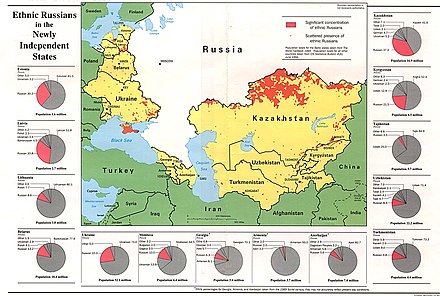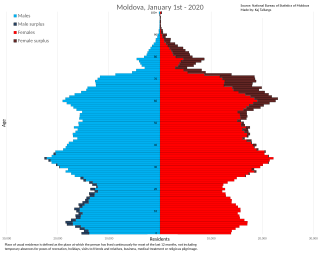
Demographic features of the population of Republic of Moldova include distribution, ethnicity, languages, religious affiliation and other statistical data.
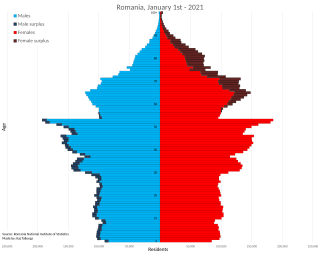
Demographic features of the population of Romania include population density, ethnicity, education level, health of the populace, economic status, religious affiliations, and other aspects of the population.

The Commonwealth of Independent States (CIS) is a regional intergovernmental organization in Eurasia. It was formed following the dissolution of the Soviet Union in 1991. It covers an area of 20,368,759 km2 (7,864,422 sq mi) and has an estimated population of 239,796,010. The CIS encourages cooperation in economic, political, and military affairs and has certain powers relating to the coordination of trade, finance, lawmaking, and security, including cross-border crime prevention.

Kyrgyzstan, officially the Kyrgyz Republic, is a landlocked country in Central Asia, lying in the Tian Shan and Pamir mountain ranges. Bishkek is the capital and largest city of the country. Kyrgyzstan is bordered by Kazakhstan to the north, Uzbekistan to the west, Tajikistan to the south, and China to the east and southeast. Ethnic Kyrgyz make up the majority of the country's 7 million people, followed by significant minorities of Uzbeks and Russians.

Since the first human spaceflight by the Soviet Union, citizens of 47 countries have flown in space. For each nationality, the launch date of the first mission is listed. The list is based on the nationality of the person at the time of the launch. Only 7 of 48 countries have been represented by female "first flyers". Only three nations have launched their own crewed spacecraft, with the Soviets/Russians and the American programs providing rides to other nations' astronauts. Twenty-eight "first flights" occurred on Soviet or Russian flights while the United States carried eighteen.

The Polish diaspora comprises Poles and people of Polish heritage or origin who live outside Poland. The Polish diaspora is also known in modern Polish as Polonia, the name for Poland in Latin and many Romance languages.
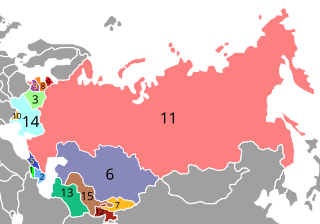
The post-Soviet states, also referred to as the former Soviet Union (FSU) or the former Soviet republics, are the independent sovereign states that emerged/re-emerged from the dissolution of the Soviet Union in 1991. Prior to their independence, they existed as Union Republics, which were the top-level constituents of the Soviet Union. There are 15 post-Soviet states in total: Armenia, Azerbaijan, Belarus, Estonia, Georgia, Kazakhstan, Kyrgyzstan, Latvia, Lithuania, Moldova, Russia, Tajikistan, Turkmenistan, Ukraine, and Uzbekistan. Each of these countries succeeded their respective Union Republics: the Armenian SSR, the Azerbaijan SSR, the Byelorussian SSR, the Estonian SSR, the Georgian SSR, the Kazakh SSR, the Kirghiz SSR, the Latvian SSR, the Lithuanian SSR, the Moldavian SSR, the Russian SFSR, the Tajik SSR, the Turkmen SSR, the Ukrainian SSR, and the Uzbek SSR. In Russia, the term "near abroad" is sometimes used to refer to the post-Soviet states other than Russia.
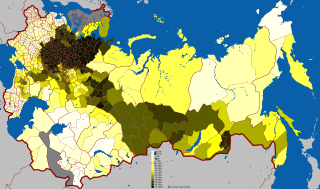
This article details the geographical distribution of Russian-speakers. After the dissolution of the Soviet Union in 1991, the status of the Russian language often became a matter of controversy. Some Post-Soviet states adopted policies of derussification aimed at reversing former trends of Russification, while Belarus under Alexander Lukashenko and the Russian Federation under Vladimir Putin reintroduced Russification policies in the 1990s and 2000s, respectively.

National delimitation in the Union of Soviet Socialist Republics was the process of specifying well-defined national territorial units from the ethnic diversity of the Union of Soviet Socialist Republics (USSR) and its subregions.

Soviet Central Asia was the part of Central Asia administered by the Soviet Union between 1918 and 1991, when the Central Asian republics declared independence. It is nearly synonymous with Russian Turkestan in the Russian Empire. Soviet Central Asia went through many territorial divisions before the current borders were created in the 1920s and 1930s.

The Russian diaspora is the global community of ethnic Russians. The Russian-speaking (Russophone) diaspora are the people for whom Russian language is the native language, regardless of whether they are ethnic Russians or not.
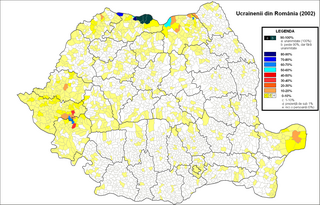
The Ukrainians of Romania are the third-largest ethnic minority in Romania. According to the 2011 Romanian census they number 51,703 people, making up 0.3% of the total population. According to the 2021 Romanian census, there were 45,835 people who identified themselves officially as Ukrainians (0.24%), and 40,861 who declared that their language was Ukrainian. According to the 2021 Romanian census, there were 834 people who identified themselves officially as Rusyns, and 594 who declared that their language was Rusyn. Ukrainians claim that the number is actually 250,000–300,000. Ukrainians mainly live in northern Romania, in areas close to the Ukrainian border. Over 60% of all Romanian Ukrainians live in Maramureș County (31,234), where they make up 6.77% of the population. According to the U.S. Census Bureau, in 2015, there were 345 ethnic Ukrainians born in Romania who lived in the United States of America at that time.

Satulung is a commune in Maramureș County, Romania. Its name, translated in English, means "the long village". It is composed of seven villages: Arieșu de Pădure (Erdőaranyos), Fersig (Fehérszék), Finteușu Mic (Kisfentős), Hideaga (Pusztahidegkút), Mogoșești (Magosfalu), Pribilești (Pribékfalva), and Satulung.
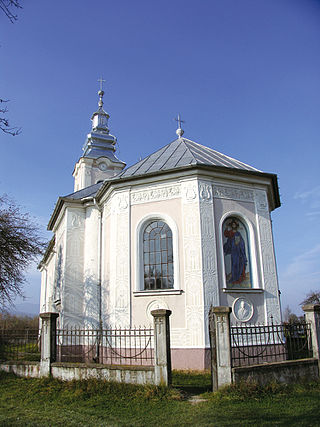
Lunca is a commune in Bihor County, Crișana, Romania. It is composed of six villages: Briheni (Berhény), Hotărel (Határ), Lunca, Sârbești (Szerbesd), Seghiște (Szegyesd), and Șuștiu (Susd).

Kazakhstan is a multiethnic country where the indigenous ethnic group, the Kazakhs, comprise the majority of the population. As of 2024, ethnic Kazakhs are about 71% of the population and ethnic Russians in Kazakhstan are about 14.9%. These are the two dominant ethnic groups in the country with a wide array of other groups represented, including Ukrainians, Uzbeks, Germans, Tatars, Chechens, Ingush, Uyghurs, Koreans, and Meskhetian Turks.

The Evangelical Lutheran Church in Russia, Ukraine, Kazakhstan and Central Asia, also known as the Evangelical Lutheran Church in Russia and the Other States (ELCROS), is a Lutheran denomination that itself comprises seven regional Lutheran denominations in Belarus, Georgia, Kazakhstan, Kyrgyzstan, Russia, Ukraine, and Uzbekistan as well as individual congregations in Azerbaijan, Tajikistan, and Turkmenistan. Established in its current form in 1999, ELCROS currently has about 24,050 members in more than 400 congregations within its jurisdiction.
Armenians in Central Asian states: Uzbekistan, Kazakhstan, Kyrgyzstan, Tajikistan and Turkmenistan, were mainly settled there during the Soviet era for various reasons.
Ukrainians in Moldova represent Moldova's largest ethnic minority. According to the 2014 Moldovan census, 181,035 ethnic Ukrainians lived in Moldova, representing 6.6% of the population of the country.
The football tournament at the 1956 Spartakiad of Peoples of the USSR was a preparatory competition for the Soviet Union national football team for the upcoming 1956 Summer Olympics. The competition took place on August 2 – 16, 1956 as part of the Spartakiad of Peoples of the USSR. The Soviet team has already qualified for the Olympic tournament by winning a play-off match up against Israel national football team earlier in July 1956. The Soviet team competed under the name of the Moscow city team.
The 2021 Romanian census was a census held in Romania between 1 February and 31 July 2022, with the reference day for the census data set at 1 December 2021. The census was supposed to be done in 2021, but it was postponed due to the COVID-19 pandemic in Romania in order to avoid census takers from getting infected when coming into contact with ill or quarantined people. It was the first census held in Romania in which data was collected online, something that had support among Romanian youth.
